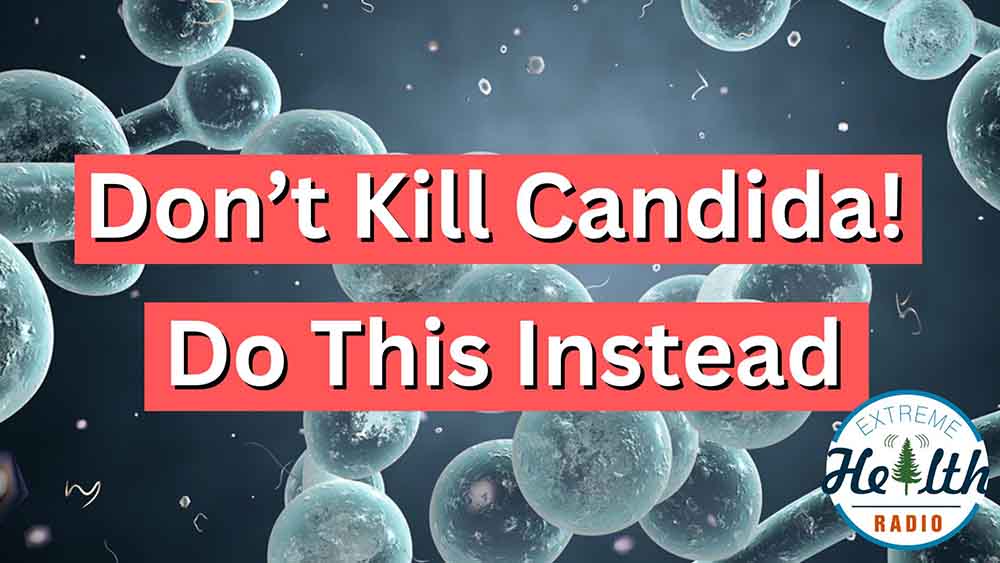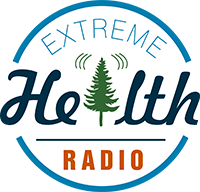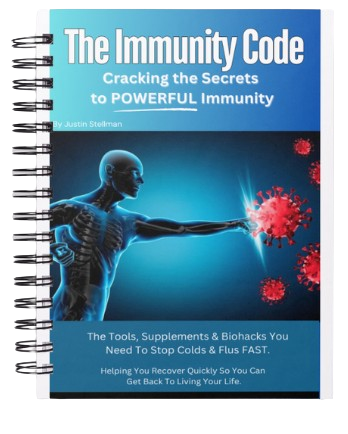
Did you know that yeast infections are good? In fact, without candida and yeast infections you would die.
Think of candida like house cleaners. What would happen if you never took out the trash in your home? What would happen if you never tidied up or cleaned the floor when you spilled drinks all over the ground?
Your house would attract rats, possums and even bigger more threatening predators.
On the other hand what would happen if you cleaned up all the messes you made in a day but you also did extra cleaning to clean up messes from past days? You probably wouldn’t need the cleaners (candida) at all.
When we live toxic lives where we consume processed foods, we kill our own cells (like spilling a drink on your kitchen floor). These cells can’t just sit there, they need to be expelled from the body or they need to be “consumed” (cleaners) by something else.
The problem is for most modern people, their elimination organs are clogged (liver, skin, colon, kidneys) and are not able to get rid of metabolic waste. Since these dead cells can’t get out, they require something to consume them (candida).
If you have candida or yeast infections, there are two guaranteed things that are happening…
- You are participating in something that is killing your cells.
- Your eliminative organs are not working properly.
If you simply did a colon cleanse or liver cleanse and you stopped doing things that killed your cells, the candida or yeast infection would go away by itself.
I would recommend doing those two things first before trying natural ways to cure a yeast infection.
Natural ways to cure a yeast infection do work but what works best is living in such a way where there’s no need for candida, yeast and fungus to overgrow in the first place.
What is a Yeast Infection?
A yeast infection, aka candidiasis, is a mostly a fungal infection primarily caused by the overgrowth of Candida albicans or other Candida species. When this overgrows in the body you will know.
These crafty little organisms normally take up residences in various parts of your body, including your skin, mouth, gastrointestinal, and genitourinary tracts, but when their balance is disrupted (from eating processed foods, antibiotics, injections of various kinds and chemicals), they can multiply excessively, leading to infections. What happens is that these assults kill our cells and candida comes in to clear up the mess. Candida and years is not bad, they’re the “clean up crew”.
But what are they cleaning up?
They’re cleaning up the cells that died as a result of eating bad foods or taking mediations. These things literally kill our cells and yeast will grow to be able to “eat up those dead cells”. Candida is a good thing. Without it, you would die.
But yeast and candida need to be in balance with beneficial micro flora.
Yeast infections mostly affect vaginal area (vaginal candidiasis), but they can also manifest as oral thrush or skin infections. You can see this when a person’s tongue turns white for example.
Vaginal yeast infections occur when the natural flora in the vagina is disrupted, mostly due to taking antibiotics, high sugar intake, hormonal changes (e.g., pregnancy, oral contraceptives), and a weakened immune system.
Differences between Candida, Yeast & Fungus
Fungus
Fungi are a broad category of organisms that includes yeasts, molds, and mushrooms. Fungi are a kingdom of living organisms that are different from plants, animals, and bacteria. They can exist in many forms, ranging from single-celled organisms to complex multicellular structures.
Yeast
This is a specific type of fungus. Yuk. Yeast refers to single-celled fungi that are commonly involved in fermentation (e.g., Saccharomyces cerevisiae) and can also cause infections, like those caused by Candida. Not all fungi are yeasts, but all yeasts are fungi.
Candida
This is a genus of yeast. The term refers to a specific group of yeast species, the most common being Candida albicans. Candida species can naturally occur in the body, but when they grow out of control, they cause infections like thrush or vaginal yeast infections.
I didn’t realize this but there are actually many different types of candida like
- Candidiasis (refers to infections caused by Candida species)
- Candida albicans (the most common species causing infection)
- Candida glabrata
- Candida krusei
- Candida tropicalis
- Candida auris
- Monilia (an older term used for Candida species)
What Causes a Yeast Infection?
Primarily yeast infections are brought on by an imbalance in your system. You have both “good” and “bad” bacteria. If for example, you kill off a bunch of the “good” bacteria (through antibiotics for example) then the “bad” will take their place and cause many of the symptoms mentioned below.
If you’re consuming foods that cause internal cellular death, then fungus and yeast will proliferate in order to eat up those dead cells.
There are many ways to kill cells in your body (just like there’s many ways to kill anything). Here are some…
- Antibiotics
- Heavy metals
- Parasites
- Chemical exposure
- Chemotherapy
- Over the counter medications
- Drugs
- Processed foods (sugars, carbohydrates etc)
- Soda
- Radiation
- Poisons, toxins
- etc
The list goes on. I mean drinking gasoline will kill cells as will stress and negative thinking. When cells die, somebody needs to clean up the mess. It’s better to avoid killing your own cells than it is to use a natural way to cure a yeast infection.
Think about it.
If I make mess and then somebody comes to clean up that mess and I stop them from doing it, what do you think happens? The mess rots and then attracts other problems.
As you can tell, I’m in favor of using natural ways to cure a yeast infection, but I’m more in favor of creating a clean internal environment so you don’t have a mess in the first place.
Yeast Infection Symptoms
The main symptoms of a yeast infection are itching, burning, and discharge. It really just starts with an itch that won’t go away and although it feels good to scratch it, it feels like you can never satisfy that itch. You could scratch so hard that it bleeds.
If you have a yeast infection and do have an itch, you’ll notice that they happen in places on your body that are warm, dark and damp. Can you name a few? I’ll make it easy on you. Your crotch, armpits, butt crack, neck, etc.
If you have a burning sensation there in your genitals, you probably have a yeast infection. If you’re a woman there could be white vaginal discharge or in other cases it could show up as thrush in the mouth with a white coat on the back of your tongue.
It could also show up as cracked heals (dying cells) or toenail fungus. You could also classify dandruff as a candida overgrowth.
So now that we know we have a yeast infection, let’s look at some natura ways to cure it.
11 Natural Ways To Cure a Yeast Infection
As I mentioned these natural remedies can be used to cure a yeast infection but remember my analogy….you’re preventing the cleaners from cleaning up the internal mess you made. If you do that, it will create other problems.
Like cancer.
There are many people who believe that cancer is a fungus. Why do you think so many people have had their cancers go away by using baking soda, which kills fungus? We interviewed Doug Kauffman a few years ago about exactly this issue. He’s expanded on the work of Dr. Tulio Simoncini who was helping heal body’s who had cancer in Italy many years ago.
As a result he lost his license. Apparently Italy’s version of the FDA didn’t want a guy running around causing them to lose money by helping people heal themselves with a 5 dollar product.
So just note that internal mold can lead to cancer and possibly other diseases so getting rid of it using alternative remedies (although good for getting on top of the symptoms) doesn’t reverse the actual cause.
With that as a backdrop let’s dive int…
1. Tea Tree Oil
A 2006 study titled “Antifungal activity of tea tree oil against Candida albicans” was done in Italy, demonstrating its clear antifungal power. The study involved lab tests and found significant inhibition of azole-resistant Candida. The conclusion was that tea tree oil can be a powerful antifungal agent. – Source
2. Garlic
The study titled “Antifungal activity of allicin on Candida albicans” was conducted in Nigeria in 2004. It demonstrated that garlic significantly inhibited Candida growth, especially in drug-resistant strains, using 50 human and lab samples. The study concluded that garlic is an effective antifungal treatment. – Source
3. Coconut Oil
The study “Antifungal activity of coconut oil against Candida species” was done in Nigeria in 2007, involving lab tests on Candida cultures. Over the duration of the experiment, coconut oil exhibited strong antifungal properties. The researchers concluded that coconut oil could be a useful natural antifungal agent. – Source
4. Oregano Oil
A 2006 study titled “Oregano oil inhibits Candida albicans” was conducted in the U.S., focusing on Candida inhibition over 8 weeks. The study used lab cultures and found that oregano oil significantly reduced Candida growth. The conclusion was that oregano oil is a promising antifungal agent. – Source
5. Curcumin
The study “Curcumin as an antifungal agent” was conducted in China in 2011 with lab-based tests on Candida. Over 6 weeks, curcumin inhibited Candida growth in treated samples. The study concluded that curcumin could be an effective natural treatment for Candida infections. – Source
6. Cinnamon
A 2014 Brazilian study titled “Antifungal activity of cinnamon oil against oral Candida” involved 52 human subjects and ran for 3 months. It demonstrated that cinnamon oil significantly reduced oral Candida symptoms. The study concluded that cinnamon oil is an effective antifungal agent. – Source
A 2007 study titled “Effect of Lactobacillus on oral Candida in elderly patients” was conducted in Japan with 50 participants over 6 months. The study found that probiotics significantly reduced Candida in patients. The conclusion was that Lactobacillus probiotics can effectively manage Candida infections. – Source
8. Clove Oil
A study titled “Clove oil and its antifungal effects on Candida albicans” conducted in India in 2007 used lab-based tests on fungal cultures. Over 8 weeks, clove oil demonstrated significant antifungal activity. The researchers concluded that clove oil is an effective remedy for Candida infections. – Source
A 2018 study titled “Antifungal activity of lemongrass oil against Candida strains” was conducted in Thailand with clinical trials over 5 weeks. It showed that lemongrass oil was highly effective in reducing Candida infections. The study concluded that lemongrass oil could be used as a natural antifungal agent. – Source
The 2005 study “Antifungal properties of grapefruit seed extract against Candida” was conducted in the U.S. with lab-based tests. The study found grapefruit seed extract to be effective in reducing Candida over 4 weeks. The conclusion was that grapefruit seed extract could be used to treat Candida infections. – Source
11. Thyme Oil
A 2004 study titled “Thyme oil’s antifungal properties against Candida albicans” was conducted in the U.K. using lab tests over 8 weeks. The study demonstrated thyme oil’s ability to inhibit drug-resistant Candida strains. The conclusion was that thyme oil is an effective antifungal treatment. – Source
More Considerations
There are many other considerations like MMS, turpentine (thank you for Dr. Jennifer Daniels MD for re-introducing this medicine to the world) and even products like Yeast Control that are well worth considering. I’ve put together and entire Candida Protocol that goes through each of these in great detail that I’d highly encourage you to learn about.
Conclusion
If you take antibiotics that will get rid of the immediate symptoms but actually make the fungal infection much worse over time by permanently weaking your immune system by killing intestinal flora forever.
Always check with your doctor but I would be extremely cautious of using any kind of antibiotic for a yeast infection. Like I’ve mentioned there are natural ways to cure yeast infection but why not learn how to live in such a way as to cause less cell death?
Makes the most sense to me.
Questions
- Do you currently have a yeast infection or candida?
- What are your symptoms? What have you tried?
- Has it worked? Do you keep getting them?
- What do you think causes your yeast infections?
Comment below.


